When the average person heads out the door for work in the morning they typically have the following items: keys, cell phone, and wallet or purse (including cash, credit/debit cards, driver’s license, etc.)
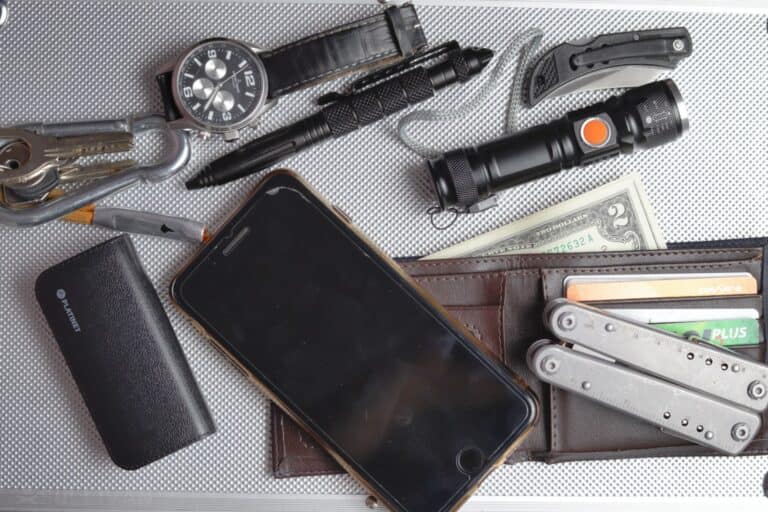
(Get our recommended list of EDC essentials here.)
Depending on your line of work, you may also have your lunch or a day planner, tablet, or laptop. For most people, on their average day, these items are fine for going to work and coming home without incident.
What if there IS an incident? Then what? My keychain, has a small Swiss knife, a flashlight, and a Kubotan on it just in case.
Your everyday carry kit consists of all the things you should have on your person at all times, in case a disaster or an emergency catches you away from your bug-out bag bags. As a result, this kit is much more available to you and you’re much more likely to use it.
There is a saying that I always try to live by, it says that “it is better to have it and not need it, than to need it and not have it”. That mindset is like having a fire extinguisher under the kitchen cabinet. It’s likely been there for years.
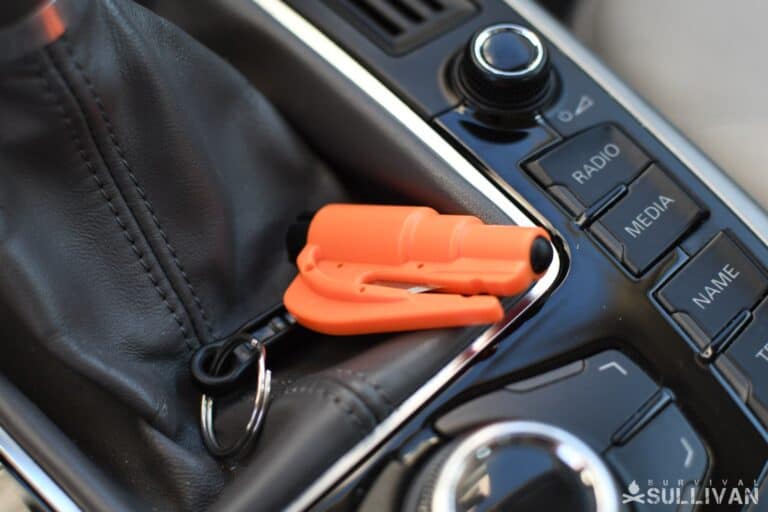
You hope that you never have to use it, but it gives you some comfort just knowing it’s there. That’s the way I think about everything I have on my person or in my car daily:
- my sidearm
- my ball of paracord
- my knife
- my emergency tool kit
- my glass breaker
- my spare tire
- my flares
- my space blankets
- my flashlight
- my multi-tool
- my rain poncho
- my chemical hand warmers
- my first aid kit
- my jug of water
I’m in a better state of mind just knowing those items are there, but I hope that I never need any of them. But of all of these items that many of us carry every day, which items are really the most critical?
Is there a difference between an EDC kit and a get-home bag? It depends. You can consider your laptop bag to be your get-home bag and your EDC to be whatever’s in your pockets. However, if you’re a woman, your purse can play both roles.
When you think about their contents, EDCs and get-home bags items often overlap, so please keep an open mind about these namings and acronyms. What matters is that you’re protected.
Your bug-out bag stays at home. Your get-home bag is either in your car or in a drawer inside your desk at work, but your EDC items should be on your person at all times.
Sure, everyone has a smartphone and their house keys, but what we need are survival items that could make the difference between life and death one day. There’s a chance you’ll be faced at least once in your lifetime with situations such as:
- a street fight
- someone following you
- someone (or you!) fainting right in front of you
- a car crash
- …and many more.
Table of Contents
The Anatomy of an EDC Item
Before moving on to the full edc list, consider these important aspects of your EDC items:
- ✅ they need to be small enough for you to carry them with you in your pockets
- ✅ they need to be useful for the SHTF scenarios you might face
- ✅ some could also act as self-defense weapons if need be
- ✅ you’re gonna need something to help you open things (such as doors and vending machines), start a fire, or fix things such as pipes
- ✅ you need something to help you cut things
- ✅ you need something to tie things
- ✅ have something to filter water with
- ✅ some can be worn around your neck
- ✅ have means of communication (a phone is great but consider something like an emergency whistle, particularly if you live in the countryside)
- ✅ last but not least, consider something to help you escape should you get tied down, kidnapped or locked away somewhere
Obviously, having a cell phone, your wallet, and your keys just won’t cut it, so let’s see a full list of items you should do your best to have with you at all times.
EDCs For Different Climates
In the world of business, they say that location is the most important factor to success. Well, location is also an important factor in deciding what the FIVE most critical items are for your EDC. That’s because the part of the world in which you live dictates what the most important EDC items are.
If you live in a place that doesn’t allow the carry of handguns then you can’t put those on your list. If you live in a place that has an average annual temperature of 75 degrees then the space blanket probably isn’t very critical for you to have either.
However, if you live in a desert climate like in Arizona, then you WILL need to include the space blanket in your critical EDC items. That’s because although the temperatures are high in the daytime, at night the temperatures drop dramatically.
You might be concerned about having a heat stroke if you are stranded in the desert by a broken-down car in the daytime. But after the sun goes down then you are worrying about freezing. In that environment, you would also want to make sure you have plenty of water on hand at all times by keeping a couple of gallons in the car.
If you live in the bush in a state like Alaska, you will need an entirely different set of EDC items than the person that lives on Manhattan Island, in New York City. First off, they aren’t allowed to carry handguns in New York.
Mean while in the Alaskan bush, not only can you carry a handgun, but you SHOULD carry a handgun. A big handgun, like a .44 Magnum, or .454 Casull. The reason why is, in the Alaskan bush, you may encounter a hungry grizzly bear. There’s not much you can do if he wants you for dinner either, except to shoot him with a large caliber handgun.
Really it’s the same as the warm weather stuff but the cold pack should be changed for hand warmer packs or a hot pack and you should always keep some space blankets in the car.
This guy has a good idea to carry stuff in the car on his visor:
Law of Averages
I suppose if you had to make a list of the 5 most critical EDC items that would cover a wide range of scenarios and conditions you could do it. But, how will we define EDC (everyday carry)?
Does every day carry only apply to items that you can carry on or about your person? Or does every day carry apply to items that you can keep in your vehicle as well?
Pictured below is a car kit that is in the pouch on the back of the seat in every car we have:
Or maybe we should make two lists? One list that is for the five most critical items to have on or about your person for every day carry.
Then another list that says the five most critical items to keep in your vehicle for every day carry. To be the most thorough I feel that making two lists is the best way to go.
This guy discusses edc items that are air travel friendly:
36 EDC Essentials to Consider
Here they are. Just keep in mind you don’t need to carry all of them, just the ones you think you’ll need.
Some people live in small towns and will need a different set of items than those living in urban settings. Women carry purses, so they’ll be able to fit more things.
#1. Wallet
The bigger the wallet, the more stuff you can fit in it – that’s pretty obvious. In addition to cash and IDs, there are some other EDC items that will fit into one, such as a Fresnel lens or a credit card knife.
One thing you can do is get a phone case that acts as a wallet for at least some items. These aren’t typically a good fit to carry change, though:
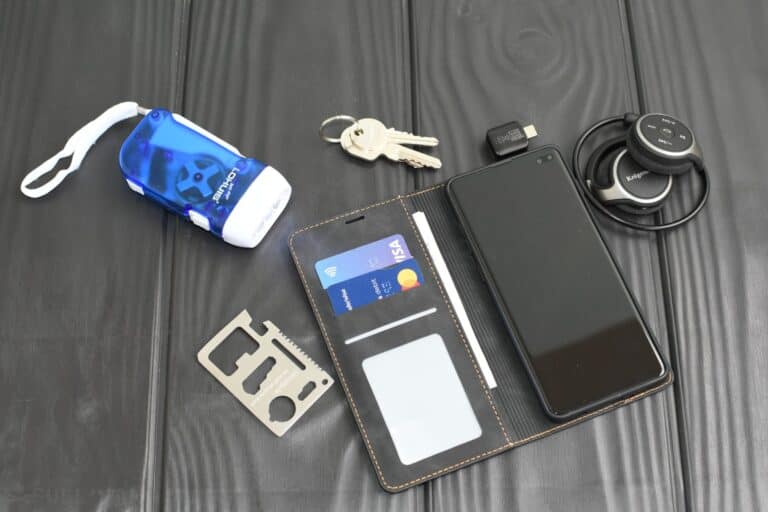
Another thing I own and used is this credit card holder that is shockproof and also has an included external battery to carry your phone. Its size is limited and the charging cable doesn’t fit into the case itself very well, but still, it might be right for you:
#2. Cell Phone
Your phone is probably the most important survival asset of the modern prepper. Not only can you make emergency phone calls, you can also load it with a ton of survival information.
A rugged phone is ideal, but a regular smartphone with a good phone case will do.
You may also want to purchase your phone unlocked, so you can switch SIM cards if your service provider becomes unavailable in an emergency. You’ll probably end up spending less money in the long run, anyway.
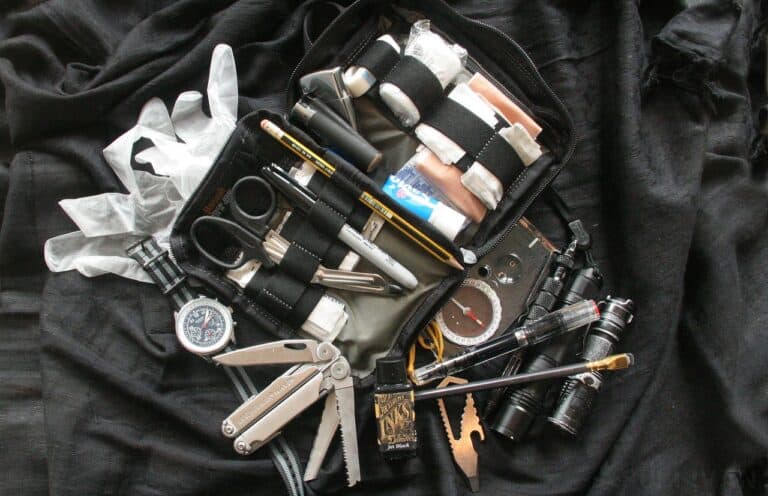
#3. Pocket Folding Knife
Folding knives could save you from more emergency situations than you can imagine. However, the last thing you want is to have your trusted companion fail you when you need it most.
This is why you need a solid edc knife that won’t break the bank.
#4. (Mechanical) Watch
Why mechanical? Well, it’ll continue to function in the event of an EMP disaster. Some watches even have extra functionality such as a compass, a barometer, and an altimeter. You obviously want it to be waterproof and shockproof.
#5. Button Compass
You probably won’t need one if you’re in an urban setting, but who knows when it could be of use.
#6. Hat
The type of hat you wear every day depends on how you dress, what kind of job you have and so on but, essentially, a good hat should do two things well:
- to keep the sun out of your eyes
- …and to ideally allow you to hide some of your EDC items. Yes, some hats have special compartments that will allow you to keep small and lightweight things such as cash.
#7. A Pen
Pens have gotten technologically smart as well. Some have flashlights, others can be used as self-defense weapons. But don’t forget that the purpose of a pen is to write with.
#8. A Small Notebook
If you like taking notes the old-fashioned way, how about one that’s water-resistant? Who knows what emergency will threaten your well-being (or that of your loved ones), so writing amidst raindrops is the only way…
#9. Small Flashlight
There are plenty of flashlights suitable for everyday carry, but did you know some of them are so small, you can attach them to your key ring? Careful though, as the smaller they are, the less reliable they tend to be.
If you could get a flashlight that’s hand-crank, you wouldn’t have to worry about dead batteries – ideal in an emergency.
#10. Paper
If you don’t carry a notebook, then at the very least carry a piece of paper in your wallet, you never know when it might be useful. In an emergency, you could use it as tinder to light a fire.
#11. Band-Aids
No survival kit should be without an assortment of bandages. Cuts and bruises happen all the time, let alone in an emergency situation.
If you have several wallets you rotate (ladies, I’m talking to you), I would highly recommend that you keep at least a couple of bandages in each of them. You just never know.
#12. Small Whistle
A whistle you can attach to your keyring will get people to think it’s cute, but you’ll know you might use it someday to save your life.
#13. Chapstick
This one is self-explanatory, right? Well, as turns out, chapstick has many survival uses such as stopping small cuts from bleeding, starting a fire, and to lubricate things such as zippers, screws, and nails.
#14. A Handkerchief
You can probably imagine all of the uses the noble handkerchief has in daily life. I’m not sure why people stopped wearing them.
#15. A Multi-tool
It can be credit card shaped or one you can add to your key ring.
#16. Fresnel Lens
Another survival item you should love because it can fit in your wallet, and won’t cause you to worry about which pocket to keep it in every day. Use it for signaling, starting a fire, and more.
#17. Fish Hooks
This is something mostly rural folks would want to carry in their EDC kits.
#18. Firestarter
You can probably find one for less than 5 bucks, and you can add it to your keychain or wear it around your neck.
#19. Lighter
The obvious use would be to start a fire for whatever reason. If you have enough room in your bag or purse, keep two lighters… just in case.
#20. Waterproof Matches
If your lighter doesn’t work, a waterproof match might. Fire is one of the most basic survival needs, so having two ways to start it is pretty important.
#21. Bandanna
Yet another survival item with a million and one uses. From protecting your head and neck from the elements to melting snow, the number of ways in which you can use it is limited only by your imagination.
#22. Can and Bottle Opener
This was suggested by one of the commentators, keep them coming, guys!
The utility value of these openers is pretty clear. I’m sure you wish you had a bottle opener on more than one occasion, and save yourself the trouble of having to find someone who does.
#23. Mil-Spec Paracord
What, paracord in your EDC? Well, only if you have the room. You’re obviously not going to wear it in your pocket or around your waist, so you only have a few options. This is a very versatile item. It has so many uses they are virtually endless.
One would be to get only 10 feet, and keep those in your car or backpack. The other would be to get a Paracord bracelet that you can wear around your wrist.
You can have a key chain or bracelet made from paracord that you can take apart if the need should arise. A bracelet made of paracord usually has one foot of paracord per one inch of bracelet length (depending on the weave or knot work).
You can wear two or three paracord bracelets if you want to, in order to make sure you have plenty on you. You can even make a pants belt out of paracord, that way you will have a LOT of paracord with you all the time.
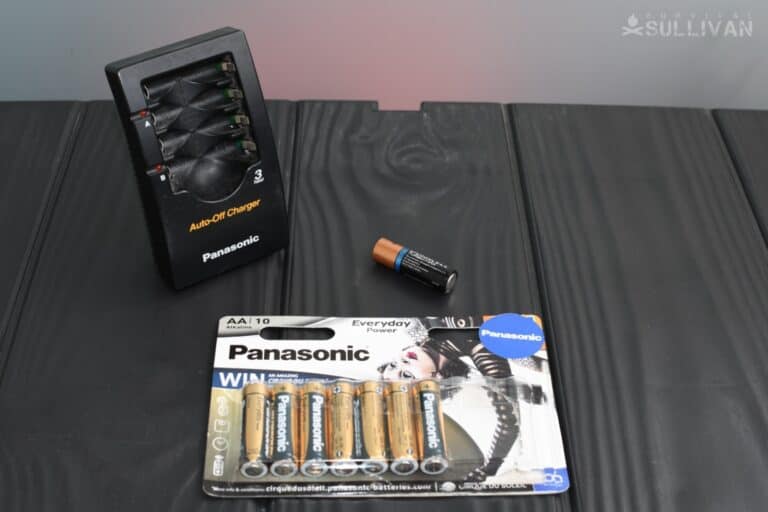
#24. Spare Batteries
Whether it’s a cell phone or a flashlight battery, you cannot be left without power. ideally, you should have spares for every device in your EDC kit and your get home bag.
#25. Cash
We may be heading towards a cashless society, but until then, during a blackout or when ATMs stop working, cash is and will be king. Be sure to keep some spare change for vending machines – just in case.
What do you need money for if you are lost out somewhere you ask? Well, if you are stranded and encounter a person, cold, hard, cash money can go a long way toward getting you back to where you need to be. In lieu of cash, you can wear some gold jewelry.
In ye olde days of the pirates and swashbucklers, they used to wear long gold chains around their necks and they would cut off a link or two and pay for everything from food and drink to “dessert”.
If you are stranded you can’t rely on the kindness of others. But you can usually rely on their greed. Offering to pay for a ride with some cash or a chunk of gold usually meets with a positive response.
#26. Small Solar Charger
Disclosure: This post has links to 3rd party websites, so I may get a commission if you buy through those links. Survival Sullivan is a participant in the Amazon Services LLC Associates Program. As an Amazon Associate, I earn from qualifying purchases. See my full disclosure for more.
Charging your phone and device off-grid could literally be a lifesaver if you’re left with a dead battery. So how about this one?
#27. Safety Pins
Nothing to add here. Suffices it to say you’ll find yourself on more than one occasion wanting to secure things.
#28. Water Purification Tablets
These are small, and inexpensive, and they take care of one of the most critical survival issues: clean, drinking water. They literally kill all bacteria and viruses in the water in about 30 minutes.
#29. Personal Water Filter
if you want something more practical than the aforementioned water purification tablets, a personal water filter is a great choice. However, if you’re worried about viruses, you might want to throw in a purification tablet too.
I recommend the Sawyer Mini because it’s smaller than the Lifestraw, but also able to better purify more water.
#30. Pepper Spray
Pepper spray is probably the most common non-lethal self-defense weapon. It’s a nice backup to have, particularly since you can purchase mini-bottles that you can attach to your keychain.
#31. Cotton Balls
Can be used to stop a scrape from bleeding, to clean a dirty surface, or to start a fire.
#32. A Mini First Aid Kit
It can fit in one of the pockets of your cargo pants or inside your purse, although this is more of a “get home item”. These typically include band-aids, which we listed separately because they’re so important.
Regardless, it wouldn’t hurt to pack extra band-aids in your wallets or to keep them in your pockets, as suggested above.
#33. OTC Medication
You need a few basic over-the-counter meds such as Ibuprofen, Benadryl, Tylenol, Aspirin, and/or antacids for obvious reasons.
#34. Paper Clips
These are so tiny, you won’t even remember you have them. But they could prove very useful one day.
#35. Superglue
Superglue can be used to glue things together (obviously), but also to seal minor wounds. However, before you try something like this, I highly recommend you talk to your physician.
#36. Handgun
If the laws allow it, carrying a handgun with you is probably the most important thing you can do for your protection. The topic of the best survival gun has been debated over and over again, and so have concealed carry holsters, so we won’ be doing that here.
You should also pick a good concealed carry holster, maybe even carry a spare mag with you just in case.
Micro-Items You Can Attach to Your Key Ring
There are a number of survival items that fit on your key ring. Yes, it’ll get bulky but if you have a purse or a pouch, that won’t be a problem. Some of the micro-items you can add:
- a micro-flashlight
- a tiny pepper spray can
- a small multitool
- and even a tiny whistle
Smart Ideas to Carry More EDC Gear
If you’re looking at the above list going:
Wow, I could NEVER fit most of these in my jeans’ pockets!
…there’s no need to worry. You just need to wear the right clothes and accessories that will help you carry more stuff. For example:
- your key chain
- a carabiner
- cargo pants (they have lots of pockets)
- your phone or tablet case (some of them have credit card slots)
- a belt pack (you can fit a huge number of small items in it)
- a bigger purse
- a shirt with a front pocket
- a lanyard (to hang stuff around your neck) that won’t be visible from underneath the shirt or t-shirt;
- a paracord bracelet can have other useful stuff inside, such as fire starters and whistles
- you can get one of those capsule containers that can fit anything, from the items listed above to powders and medicine
- …or even a travel-friendly multitool bracelet.
How Do You Pick Which Items to Carry?
You probably saw this coming but the things you carry with you everyday depend on yourself, on your location, your unique situation and all the possible (and likely!) scenarios that may hit you. That’s right, you can’t prepare for everything with a small EDC…
Whether you’re in an urban or a rural situation – that’s a big factor. Another one is your gender.
If you’re a lady, you might want to carry wasp or pepper spray in your (large) purse. If you’re a guy, on the other hand, you’re probably going to rely on your gun or on your edc knife and, of course, on your strength.
Last but not least, think about the situations you might face. Are riots likely to happen? In this case, you’re definitely gonna need some cash (to pay for your freedom) and a bandanna to give just a few examples.
Do you live in a rural area and you want another means of signaling your loved ones from a distance? Get a whistle.
Many of the items in this EDC list have, as you can see, dozens of uses so, the thing you should do next is to learn how to use them.
Your Phone’s EDC
I don’t think anyone talked about this before so I will. Your smartphone is capable of storing quite a bit of crucial information.
Only problem is, most people are unaware of that. To give you a few examples, here’s what you can save offline:
- maps of your surrounding areas (some apps offer the option to save them offline which is very useful because then you don’t need a 4G connection to navigate – keep in mind the dot moving on the map which is you is updated directly through satellite, not through your phone carrier)
- lots of survival apps
- an e-copy of your car’s owner’s manual (you never know)
- e-copies of all your important papers and documents
- a special folder with your emergency contacts (the way you organize these depends on your phone’s mobile operating system)
- survival eBooks (obviously)
- and more.
Have you noticed that none of the above will increase the weight of your EDC by even one ounce? 🙂 All you need is a smartphone with a comfortable 32 GB of storage space.
By the way, did you know that your cell phone has many other uses besides the ones it was meant for?
For example, you can use it to start a fire (you need the battery and some kindling), as a signaling mirror, use the flashlight function, you can even use the circuit board to cut stuff.
One Item You Shouldn’t Have in Your Kit
That item is water. It’s hard carrying with you at all times, as it’s really heavy. I’m not trying to say it’s is not important, far from it, but you should keep your bottle inside your get home bag.
Remember that you don’t want your gear to slow you down when you’re doing your daily chores, let alone when you’re running for your life.
EDC Kit Examples
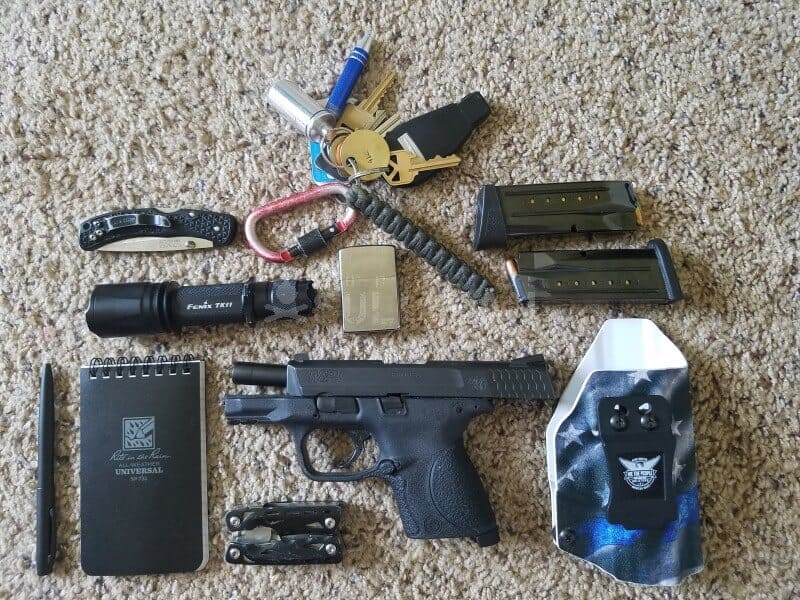
Steven Hensley’s EDC Kit
Everyday Carry, or EDC, is very important to me. It’s the first level of preparedness and is the gear that you know you will be going into any situation with because it’s on your person. I am often out in the woods alone working, so having gear I can depend on is crucial. Here is my list:
- Lighter- A lighter serves so many purposes that I feel it’s a must. I carry a Zippo brand classic lighter. The Zippo is very wind-resistant, has a good intense flame, is refillable, and has replaceable wicks and flints. I have carried them for years and never had an issue. You do have to remember to keep them filled, even if you don’t use it often.
- Flashlight- A flashlight can be a fantastic tool to have in a lot of everyday situations and survival situations alike. I carry a Fenix TK11 Tactical Light. It is small but powerful enough to take care of most tasks. It produces around 250 lumens, which is enough to use as a task light or tactical light, without being too powerful to use in small areas. The only downside is that it uses CR123 batteries, which are not as easily accessible as standard batteries.
- Handgun- An absolute necessity. Personal protection and to protect my family and others. I carry a Smith & Wesson M&P 9c. It is a compact frame 9mm semi-auto. It carries well and has performed flawlessly for many years. I have it loaded with Federal HST jacketed hollow-point ammo.
- Holster- I carry a We The People brand inside the waistband Kydex holster. The one I am carrying now is their “Thin Blue Line” holster. These holsters are comfortable and feel great to wear all day. They hold solid and secure with a nice “click.”
- Spare Magazine- I carry a spare magazine with a grip extender for my M&P. I keep my spare loaded up with 124g +P full metal jacket ammo. I carry the FMJ because it gives me the option to switch to something with more penetration and slightly higher muzzle energy that the JHP rounds. I also live in bear country, and you do not want to run into an angry bear with only JHP in your gun.
- Pocket Knife- A good knife is as essential of a tool as you can have. I carry a Cold Steel Voyager with a tanto point and a plain blade. This knife has served me well through many years of hard work and abuse. It sharpens well and holds an edge very well.
- Multi-tool- A good multi-tool is such a handy thing to have in your pocket, but it can also be a fantastic tool in a survival situation. I carry a Gerber Suspension. It is simple, useful, and gets the job done.
- Pocket Notebook- I carry a Rite in the Rain weatherproof notebook and I find that I use it very often. You never know when you will need to write down significant numbers, descriptions, instructions, or leave a note somewhere.
- Pen- I carry a Rite in the Rain weatherproof pen and it works great, plus is waterproof. It is also smaller than other pens and fits comfortably in my pants pocket. It is made of brass and steel, so I don’t have to worry about it breaking.
- Carabiner- I carry a medium-sized locking carabiner on my keys. It’s always there and can come in handy in a lot of situations.
- 550 Cord (Key Grab)- I also have a key grab of braided 550 cord. It comes out to about 4 feet of cord that could be used in limitless ways.
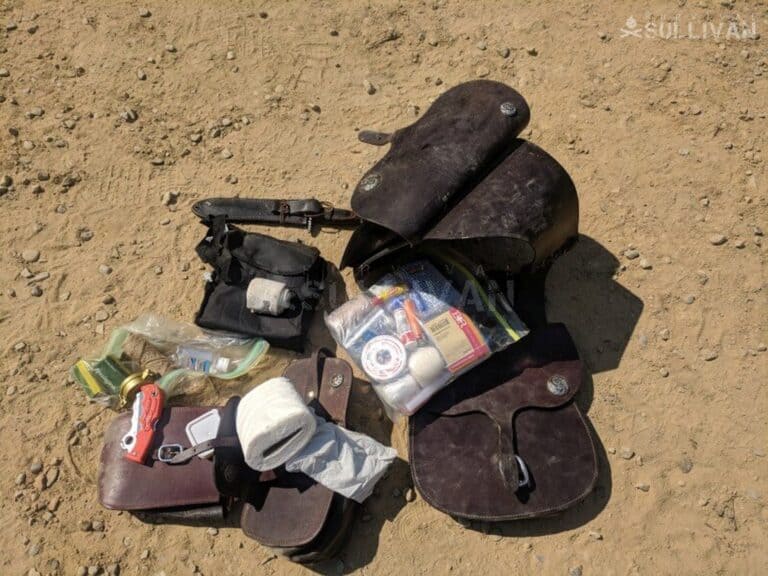
Tara Dodrill’s Rural EDC Kit
Tara lives on a 56-acres farm, so her EDC is a little different than what urban, suburban and even small-town preppers have. You can see her EDC kit above, things like:
- some very cool-looking saddle bags as her EDC pouch
- fixed-blade knife
- lighters
- folding knife
- toilet paper
- a Ruger .40 handgun
- a couple of .22 caliber rounds
- binoculars
- fire-starter
- solar charger
Megan Stewart’s EDC Kit
Some of the things you’ll find in Megan’s kit include:
- carabiner
- small flashlight
- small pocket knife
- lip balm
- …and a few others.
Greg Seebregt’s EDC
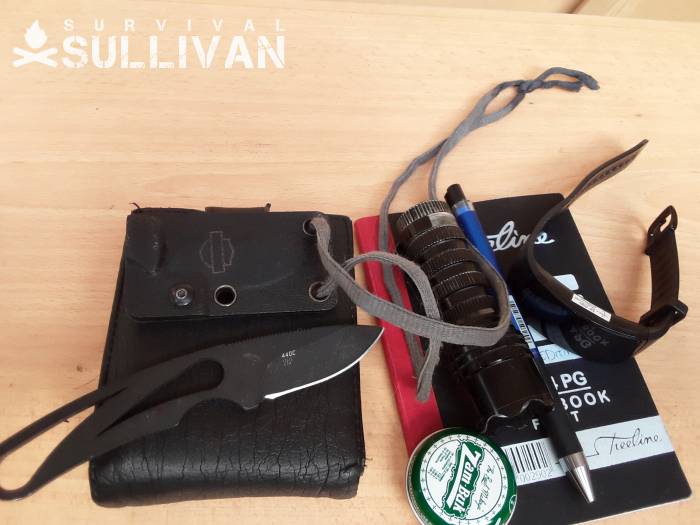
Greg’s EDC is pretty straightforward. You can see in the photo above a fixed-blade EDC knife, so you can’t tell he’s a knife enthusiast.
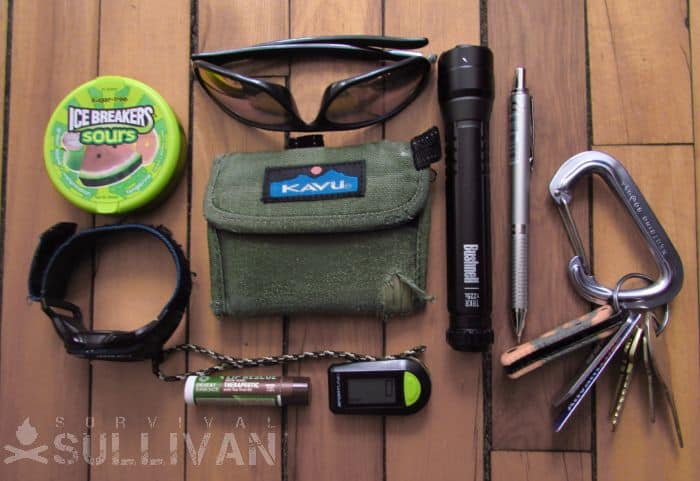
Keychain EDC Kit
Last but not least, let’s take a look at a keychain survival kit centered around a carabiner, consisting of some keys and some multitools. There are plenty of things you can attach to a keychain, by the way.
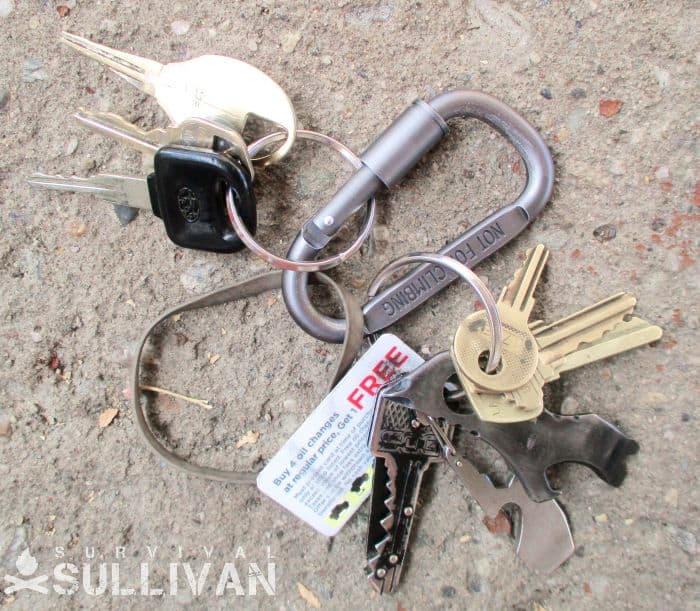
Here’s another one:
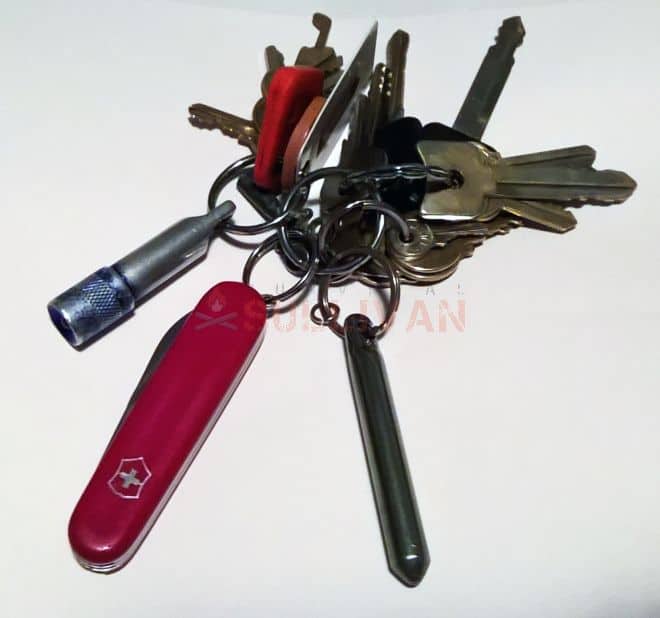
A large enough purse can hold at least a dozen essentials, if not more, while still having enough room for other day-to-day items:
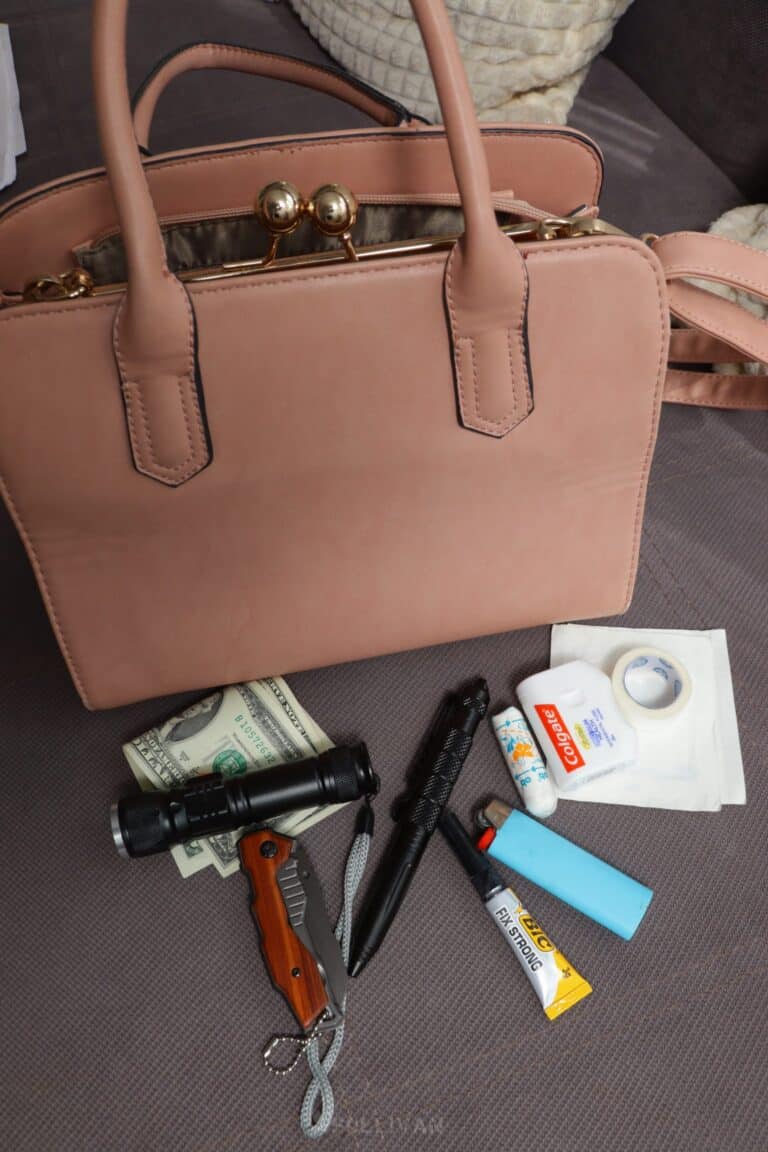
Last But Not Least…
One last thing to thing to keep in mind is that you won’t always be wearing your cargo pants or your belt pack. Sometimes you need to put on your trousers or you may ditch that shirt with a front pocket for a t-shirt.
We have a separate article on EDC load carriage options here.
Here’s what you can do… You can organize your EDC items into two categories: the ones that are essential and the ones you can afford to leave home from time to time. Either way, you should always have as many of them with you at all times.

Now, putting together your EDC kit takes a little bit of time (because you want to get quality gear), which is why I put together this handy PDF checklist that you can print and tick off as you get the items.
Until Next Time
I sound like a broken record, I know, but I can’t stress enough that your most important tool is your brain. Observe what’s going on around you, and think about the possibilities and what you would need or do in various scenarios.
When you leave in your car are you just going a couple of miles away to the store or are you driving a couple of hours away for something?
The items that are most critical to you will be different for those two scenarios, and in reality, there will probably be more than five items that could be critical.
If you really have to nail it down to only five items, then think about where you’re going and what you’re doing, or going to do. Then you will best be able to determine what the truly five will be.
In reality, I’d really hate to have to break it down to only 5 items to carry. Especially in the car since there is so much room to stow gear in a vehicle. I have to admit, mine isn’t as organized as it should be, but for the most part, it’s there.
I also have to admit that I don’t carry as much in my car as I used to, but I never really go anywhere anymore. If I plan to travel anywhere that’s a long distance away and for any kind of time away, then I most definitely pack the car to the brim with incidentals.
Because like I always say, repeat with me boys and girls, it’s better to have it and not need it, than to need it and not have it.
Don’t forget to pin this on Pinterest for later!
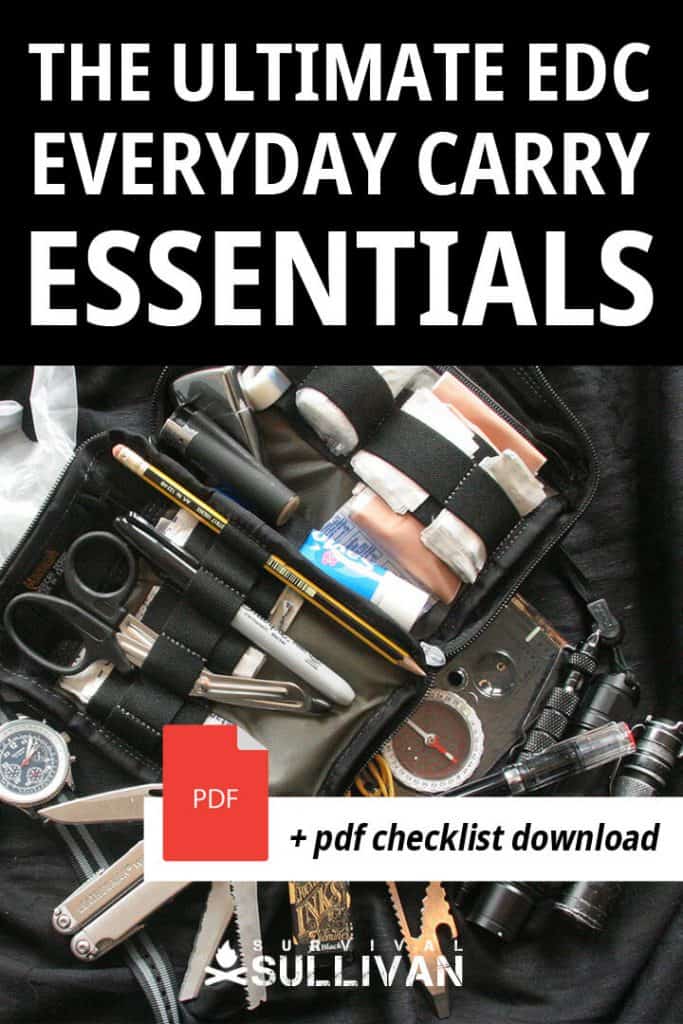

My dad was military. My grandfather was a cop. They served their country well. But I don’t like taking orders. I’m taking matters into my own hands so I’m not just preparing, I’m going to a friggin’ war to provide you the best of the best survival and preparedness content out there.

Another good one for the key ring is a P-38 can opener… I’ve carried one for over 20 years on mine…
The US Speaker P-38 are the only can openers I’ve had in my home for over fifty years.
Of course there’s one on my key ring.
People at work may think I am crazy, but I keep at least five (5) gallons of water at my desk at work, just in case. I carry water in my car. I also have one (1) bug out bag in the car and one (1) at my desk at work.
I believe your coworkers who don’t prepare for emergencies are the crazy ones.
Just wait till something happens and they have to ask you for water. I agree with Anthony that your co-workers are the dizzy ones,
mechanics gloves, they do not take up a lot of space but can save you from injury.
I highly recommend the LIGHTNING STRIKE FIRE STARTER! You may want to Google it…Fantastic primary go to for EDC. QUESTION: I am looking for an EDC Bag/Molly, that can organize my essential items. Slots or pockets! I think it needs to be roughly 10 inches by 6 inches, by 1 and 1/2 ” thick or 2″ thick. I’m looking for quality and durability. I want to be able to unzip it, lay it open, and see what I have…
Any advice out there?
Vertx EDC Gamut.. Check it out
Tactical Ditributors is one place, there are many more.
I also added zip ties too my EDC 4 each of 4 different sizes.
You definitely SHOULD carry water. I hate being without water, I won’t drink tap water, and I won’t buy water when I’m out because it is expensive.
It is the thing that has come in most handy for me out of all my EDC.
Mountain Warehouse in the UK had a nice gizmo incorporating a whistle, small light, compass, signal mirror, magnifying glass, and a space inside where I keep water purifying tablets. It’s on a lanyard too. I have one in my purse, along with a first aid kit I found in our UK equivalent of a dollar store and my pocket knife.
One item to consider is a “shemagh” an Arab scarf. One article I read stated it had over twenty different uses and was a special forces favorite.
All good ideas. Do your best and add as you can. Not prepping at all is preparing to die.
A couple of suggestions.
The Fisher Space Pens
You can get the complete pen or just refills for many of your favourite pens.
The refills last for ever in storage without drying out & will write at any angle & even on wet materials.
A perfect companion for the waterproof paper notebooks or just to make sure your pen will work when you really need it too or after long term storage.
You can get them online or on eBay.
Itch & Bite Relief – Mosquito Zap, Mosquito Click
We are in a Tropical area & bites & stings are always an issue.
My wife literally scratches her skin away with itching from mosquito & sand flies (midges), but we found a great solution many years ago that we have in ALL our kits, the car glove box, her handbags etc. The best thing is that it is very small, lightweight, inexpensive, & lasts for years.
It is a very small device that produces an electric shock like the Piezo electric starters for gas stoves.
It has two small electrodes at the bottom that put out the small shock when you push the button on top.
You just zap on the bite site & around it. It isn’t painful but it takes away the itching & reduces or completely stops swelling.
These can cost around $20 in shops but if you look up Mosquito Zap, Mosquito Click etc on eBay then they can be got for as low as a couple of dollars from Chinese suppliers – including post.
Some of the Chinese ones have weaker zaps than others but at the low price you can afford to toss a few away if you don’t find it effective & still stock your car, first aid kits, beside the bed & anywhere else than you can think of without hurting the budget.
BTW if an eBay one is not working or is too weak then you should contact the seller for a replacement.
My wife needs quite a lot of clicks on & around a mosquito bite while I normally only need a couple. You may need to repeat it later.
It also works for rashes & itches from disease.
We even gave one away to a counsellor who had an annoying itch during a session. He couldn’t believe it worked but it did.
One online user stated that he found it effective for Chicken Pox.
We have also used it for itching & rashes from skin conditions & disease with good effect although we use a cheap one & toss it after use for a disease.
We have also been told the clicker is great for ant bites & wasps & also fantastic for leaches!
If you apply after you remove the leach, then you don’t get any long-term itching.
You can also use it on ticks, but reportedly you need to do 10 – 15 clicks a couple of times in the first day after removing the tick.
The zap doesn’t hurt even if you needed dozens of clicks to get the relief.
You left off item #4. It appears to be Pepper Spray.
You list fishing hooks but nothing that would work as fishing line unless you took apart the paracord. I would recommend fishing line or dental floss.
I found Pepper Spray on your list.
You can get dental floss in a flat, credit card type dispenser. I’ve had some in my work bag for years.
Hello,
As it seems in my brain, your list up above is a list of SHTF situational gear. We cantforget that EDC means Every Day Carry. What I would bring would be:
Wallet
Cell Phone
Fixed Blade Knife
Mechanical Watch
Hat
Flashlight/Biolite/Headlamp
RITR Notebook
Zippo Lighter
Can/Bottle Opener
36 Bank Line Hanked, on a Carabiner
Cash
Pepper Spray
Glock 19 chambered in 9mm, CC
-Kyle
I’ve been going to estate sales and it’s amazing to find all the items on your lists that they’re practically giving away.
The coolest part is searching thru women’s purses and fanny packs that are perfect for carrying items…
I have put together all kinds of bags for pennies on the dollar…you should to…especially for immediate family and friends.
Agreed. My opinion only, The one thing to never leave out of your GHB.
Duct tape, in a mini roll, flat roll, or flat pack might be a good idea.
if there is an emp you won’t have any more used of your cell phone.
well maybe for a mirror.
Pick up an old phone with 32 gigs of memory to store all of the information, files, videos, contact info, maps, etc. After you’ve loaded it up, remove the battery (charge it, plus a couple others…they will go bad eventually…from time to time to keep it fresh but don’t leave it in the charger). Wrap the phone in a layer of cardboard and then put it in a protective EMP bag. While the cardboard isn’t strictly needed, it will help shield the phone from mechanical shocks and will put added distance between the phone and the EMP charged outer layer of the bag.
We’ll miss the phone and location services but that will pale compared to the missing clean, running water, the missing heating and cooling, the missing food, the missing medical/dental/eye facilities, the missing sewage facilities, the missing lights, the missing vehicles & power equipment, etc. Life will be hard.
The Lightning Strike fire starter and Lightning Strike Napalm Tinder are my go too fire starters, as well. I teach fire at some of the groups I am with when they have outings. I have 5-year old little girls get a fire going the first or second strike with mine.
When it comes to smartphones, they are one of my key pieces of prep gear. I have dozens of prepper apps on my primary use phone, but also on two old Galaxy S4 phones. The S4 has the best sensor suite of any phone before or after. They are basically wrist band computers. I keep one in a Faraday bag at all times.
Most of the apps do not require wifi or cell service to work. I have multiple ways to keep them charged and the means to recharge the power banks. I have several thumb drives and a couple of OTG cables so I can swap out software and the .pdf files and the ebooks of information that I carry with me.
I carry a paper copy (the compact Gem version) of the SAS survival manual, plus several other key paper items, but everything is on both of the phones and my tablet.
Just my opinion.